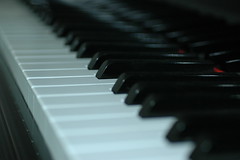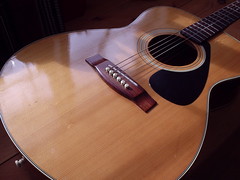Sight Reading vs. Sight Playing
In my household, several people are involved in plinking pianos and plunking guitars. I've played a little of each (more guitar than piano), and I find my perennial novice status gives me insights into the learning process, insights that seem out of reach to an experienced instructor.

courtesy of stickywiki -- Creative Commons license
First and foremost, they should really call it "sight playing" instead of "sight reading". Sight reading implies a cognitive awareness of the name of each note as you play it. I know some people can do that, but it isn't necessarily the easiest or fastest way to think about it. Sure, you have to know the notes on the staff and on your instrument well enough to get oriented at the start of a song, but after that you follow the number of steps on the scale, up or down, between the current note and the next note, and translate that to the number of necessary steps (in a given scale) on your instrument.

courtesy of milewalker -- Creative Commons license
The next thing to note is that doing this on a piano is far easier than doing this on a guitar. Why you might ask? Though it's true that learning different scales takes a similar effort on both instruments, things get harder on a guitar when you have to skip one or more notes on the scale. On a piano you dedicate a finger to each note in a scale, so skipping a note can be as simple as skipping a finger. On the guitar it takes far greater facility with the scale to be able to skip arbitrarily around from any given note.
Do you know anyone who has backed away from playing an instrument because "sight reading" seemed an impossible mental hurdle for them? Tell them about "sight playing."

First and foremost, they should really call it "sight playing" instead of "sight reading". Sight reading implies a cognitive awareness of the name of each note as you play it. I know some people can do that, but it isn't necessarily the easiest or fastest way to think about it. Sure, you have to know the notes on the staff and on your instrument well enough to get oriented at the start of a song, but after that you follow the number of steps on the scale, up or down, between the current note and the next note, and translate that to the number of necessary steps (in a given scale) on your instrument.

The next thing to note is that doing this on a piano is far easier than doing this on a guitar. Why you might ask? Though it's true that learning different scales takes a similar effort on both instruments, things get harder on a guitar when you have to skip one or more notes on the scale. On a piano you dedicate a finger to each note in a scale, so skipping a note can be as simple as skipping a finger. On the guitar it takes far greater facility with the scale to be able to skip arbitrarily around from any given note.
Do you know anyone who has backed away from playing an instrument because "sight reading" seemed an impossible mental hurdle for them? Tell them about "sight playing."

0 Comments:
Post a Comment
<< Home